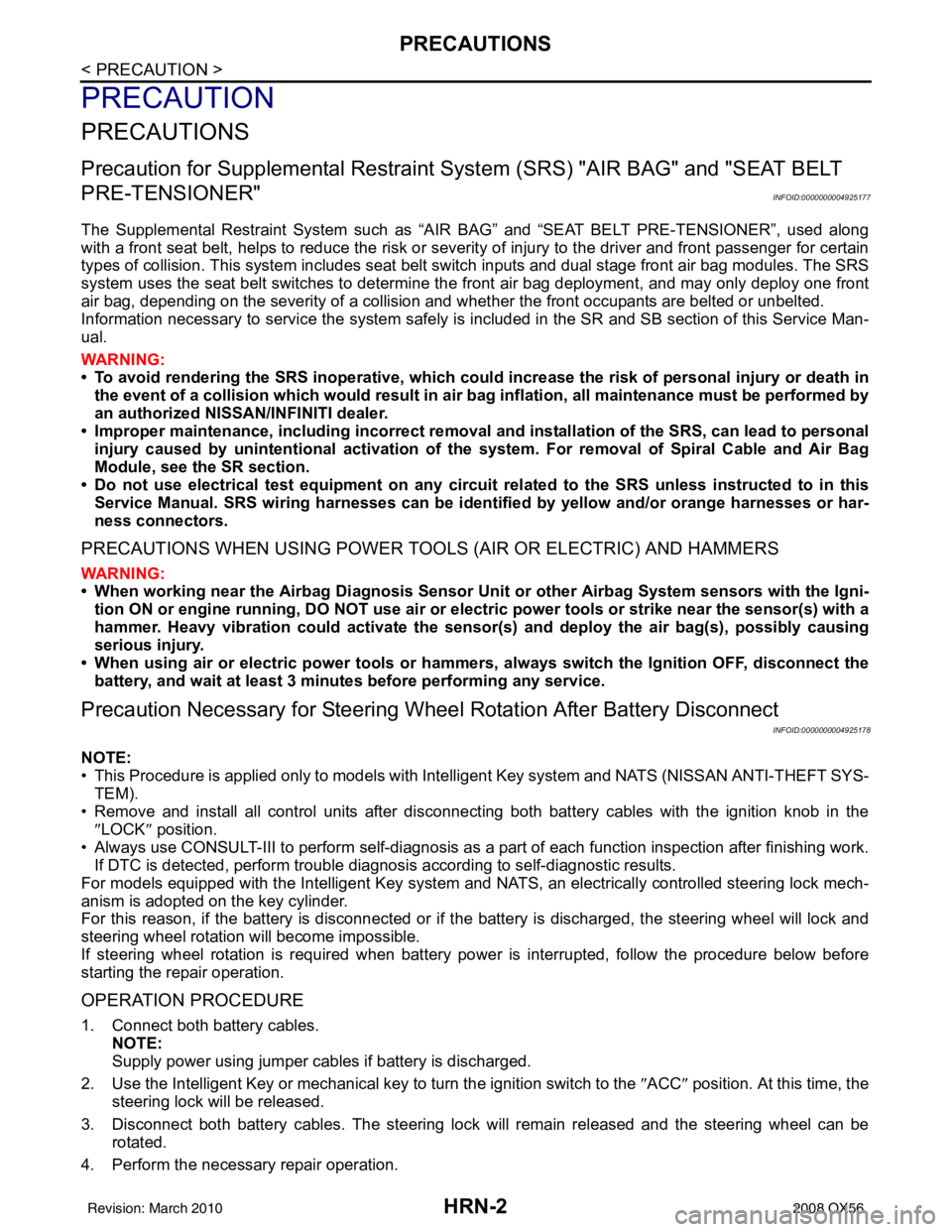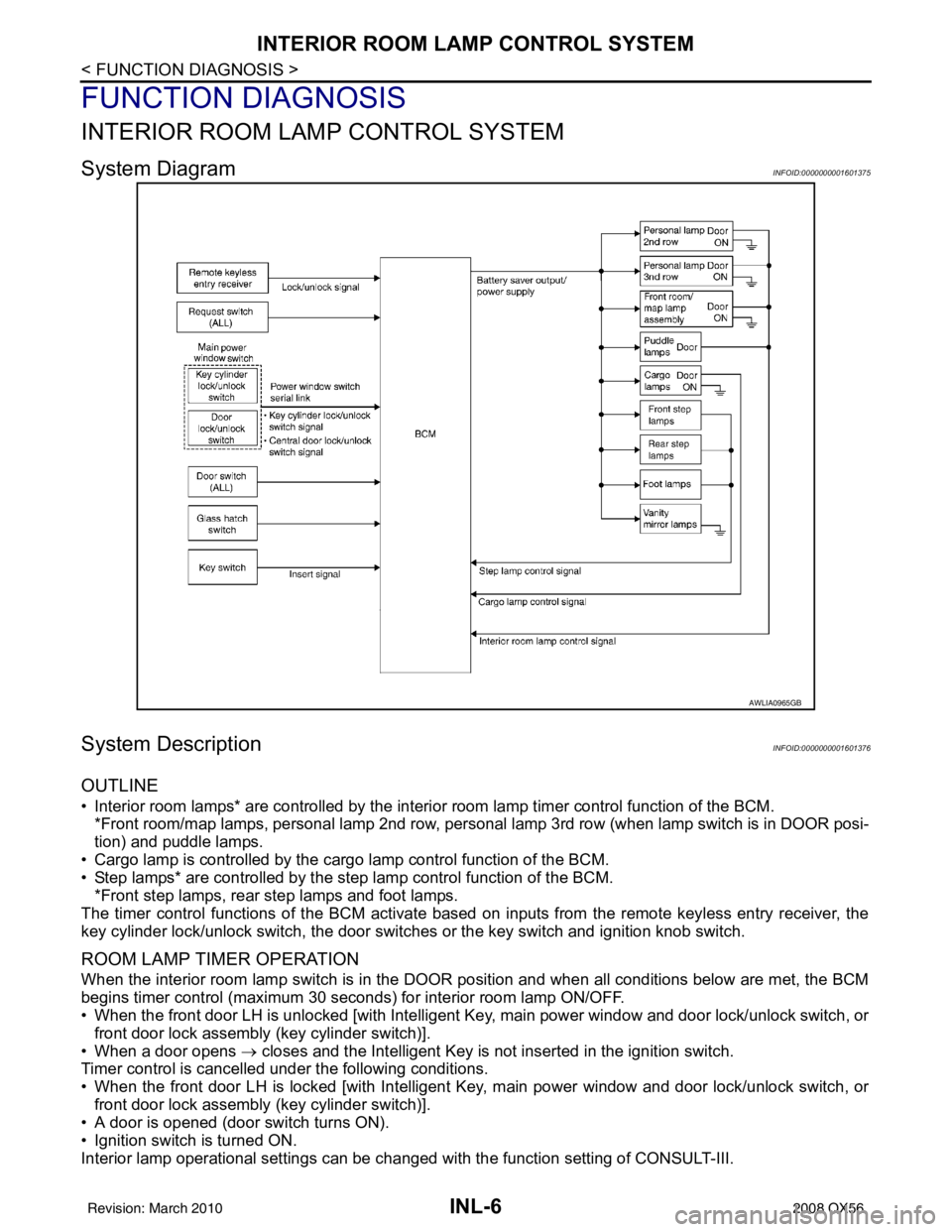2008 INFINITI QX56 lock
[x] Cancel search: lockPage 2344 of 4083
![INFINITI QX56 2008 Factory Service Manual AIR CONDITIONER CONTROLHAC-91
< ECU DIAGNOSIS > [AUTOMATIC AIR CONDITIONER]
C
D
E
F
G H
J
K L
M A
B
HAC
N
O P
13 G/R Variable blower control (front) ONBlower speed (low)
1.7V
Blower speed (high) 4.5V
INFINITI QX56 2008 Factory Service Manual AIR CONDITIONER CONTROLHAC-91
< ECU DIAGNOSIS > [AUTOMATIC AIR CONDITIONER]
C
D
E
F
G H
J
K L
M A
B
HAC
N
O P
13 G/R Variable blower control (front) ONBlower speed (low)
1.7V
Blower speed (high) 4.5V](/manual-img/42/57030/w960_57030-2343.png)
AIR CONDITIONER CONTROLHAC-91
< ECU DIAGNOSIS > [AUTOMATIC AIR CONDITIONER]
C
D
E
F
G H
J
K L
M A
B
HAC
N
O P
13 G/R Variable blower control (front) ONBlower speed (low)
1.7V
Blower speed (high) 4.5V
14 G/W Air mix door motor (passenger) CW ON Clockwise rotation Battery voltage
15 Y/G Power supply for IGN ON- Battery voltage
17 W/G Air mix door motor (driver) CW ON Clockwise rotationBattery voltage
18 G Air mix door motor (driver) CCW ON Co unterclockwise rotationBattery voltage
19 BR/W Mode door motor CW (front) ON Clockwise rotationBattery voltage
20 P/L Mode door motor CCW ON Counterclockwise rotationBattery voltage
21 G/B Intake door motor CCW ON Counterclockwise rotationBattery voltage
22 O Intake door motor CW ON Clockwise rotationBattery voltage
23 LG Defroster door motor CW ON Clockwise rotationBattery voltage
24 P/B Defroster door motor CCW ON Counterclockwise rotationBattery voltage
25 P Ambient sensor ON- 0 - 5V
26 V/R Sensor ground ON- 0V
27 Y/R Power supply for BAT -- Battery voltage
28 Y V ref ACTR (5V) ON- 0 - 5V
29 R/W Air mix door motor (passenger) feed-
back
ON
- 0 - 5V
30 R/Y Mode door motor (Rear) feedback ON -0 - 5V
31 BR/Y In-vehicle sensor motor (+) ON- Battery voltage
32 LG/R In-vehicle sensor signal ON- 0 - 5V
33 R/Y Air mix door motor (Rear) feedback ON -0 - 5V
36 B Ground -- 0V
40 P CAN-L ON- 0 - 5V
41 L CAN-H ON- 0 - 5V
42 W/V Optical sensor (passenger) ON- 0 - 5V
43 GR/R Mode door motor (Rear) CW ONClockwise rotation Battery voltage
44 L/Y Mode door motor (Rear) CCW ON Coun terclockwise rotationBattery voltage
45 Y/L Water valve ONWater valve open
Battery voltage
Water valve closed 0V
46 W/G Water valve ONWater valve open
0V
Water valve closed Battery voltage
47 O LIN BUS (rear) ON- Battery voltage
48 O LIN BUS (front) ON- Battery voltage
49 GR/R Air mix door motor (Rear) CW ONClockwise rotation Battery voltage
50 L/Y Air mix door motor (Rear) CCW ON Co unterclockwise rotationBattery voltage
Te r m i n a l
No. Wire
color ItemIgnition
switch Condition Voltage (V)
(Approx.)
Revision: March 2010 2008 QX56
Page 2362 of 4083
![INFINITI QX56 2008 Factory Service Manual INSUFFICIENT COOLINGHAC-109
< SYMPTOM DIAGNOSIS > [AUTOMATIC AIR CONDITIONER]
C
D
E
F
G H
J
K L
M A
B
HAC
N
O P
INSUFFICIENT COOLING
Component Function CheckINFOID:0000000001679830
SYMPTOM: Insufficie INFINITI QX56 2008 Factory Service Manual INSUFFICIENT COOLINGHAC-109
< SYMPTOM DIAGNOSIS > [AUTOMATIC AIR CONDITIONER]
C
D
E
F
G H
J
K L
M A
B
HAC
N
O P
INSUFFICIENT COOLING
Component Function CheckINFOID:0000000001679830
SYMPTOM: Insufficie](/manual-img/42/57030/w960_57030-2361.png)
INSUFFICIENT COOLINGHAC-109
< SYMPTOM DIAGNOSIS > [AUTOMATIC AIR CONDITIONER]
C
D
E
F
G H
J
K L
M A
B
HAC
N
O P
INSUFFICIENT COOLING
Component Function CheckINFOID:0000000001679830
SYMPTOM: Insufficient cooling
INSPECTION FLOW
1.CONFIRM SYMPTOM BY PERFORMING OPERAT IONAL CHECK - TEMPERATURE DECREASE
1. Press the AUTO switch.
2. Turn temperature control dial (driver) counterclockwise until 18 °C (60° F) is displayed.
3. Check for cold air at discharge air outlets.
Can the symptom be duplicated?
YES >> GO TO 3.
NO >> GO TO 2.
2.CHECK FOR ANY SYMPTOMS
Perform a complete operational check for any symptoms. Refer to HAC-4, "
Operational Check (Front)".
Does another symptom exist?
YES >> Refer to HAC-108, "SymptomMatrixChart".
NO >> System OK.
3.CHECK FOR SERVICE BULLETINS
Check for any service bulletins.
>> GO TO 4.
4.PERFORM SELF-DIAGNOSIS
Perform self-diagnosis Refer to HAC-22, "
A/C Auto Amp. Self-Diagnosis".
Is the inspection result normal?
YES >> GO TO 5.
NO >> Refer to HAC-23, "
A/C System Self-Diagnosis Code Chart".
5.CHECK DRIVE BELTS
Check compressor belt tension. Refer to EM-13, "
Checking Drive Belts".
Is the inspection result normal?
OK >> GO TO 6.
NG >> Adjust or replace compressor belt. Refer to EM-13, "
Removal and Installation".
6.CHECK AIR MIX DOOR OPERATION
Check and verify air mix door mechanism for smooth operation. Refer to HAC-31, "
Air Mix Door Motor Compo-
nent Function Check".
Does air mix door operate correctly?
YES >> GO TO 7.
NO >> Check air mix door motor circuit. Refer to HAC-32, "
Air Mix Door Motor (Driver) Diagnosis Proce-
dure" or HAC-35, "Air Mix Door Motor (Passenger) Diagnosis Procedure".
7.CHECK COOLING FAN MOTOR OPERATION
Check and verify cooling fan moto r for smooth operation. Refer to EC-395, "
Component Inspection".
Does cooling fan motor operate correctly?
YES >> GO TO 8.
NO >> Check cooling fan motor. Refer to EC-395, "
Diagnosis Procedure".
8.CHECK WATER VALVE OPERATION
Check and verify water valve for smooth operation. Refer to HAC-76, "
Description".
Does water valve operate correctly?
YES >> GO TO 9.
Revision: March 2010 2008 QX56
Page 2369 of 4083
![INFINITI QX56 2008 Factory Service Manual HAC-116
< SYMPTOM DIAGNOSIS >[AUTOMATIC AIR CONDITIONER]
INSUFFICIENT COOLING
Low-pressure Side
Becomes Negative
Gauge indication Refrigerant cycleProbable causeCorrective action
Low-pressure side so INFINITI QX56 2008 Factory Service Manual HAC-116
< SYMPTOM DIAGNOSIS >[AUTOMATIC AIR CONDITIONER]
INSUFFICIENT COOLING
Low-pressure Side
Becomes Negative
Gauge indication Refrigerant cycleProbable causeCorrective action
Low-pressure side so](/manual-img/42/57030/w960_57030-2368.png)
HAC-116
< SYMPTOM DIAGNOSIS >[AUTOMATIC AIR CONDITIONER]
INSUFFICIENT COOLING
Low-pressure Side
Becomes Negative
Gauge indication Refrigerant cycleProbable causeCorrective action
Low-pressure side sometimes be-
comes negative. • Air conditioning system does
not function and does not cy-
clically cool the compart-
ment air.
• The system constantly func- tions for a certain period of
time after compressor is
stopped and restarted. Refrigerant does not discharge
cyclically.
↓
Moisture is frozen at expan-
sion valve outlet and inlet.
↓
Water is mixed with refrigerant.
• Drain water from refrigerant
or replace refrigerant.
• Replace liquid tank.
AC354A
Gauge indication Refrigerant cycleProbable causeCorrective action
Low-pressure side becomes nega-
tive. Liquid tank or front/rear side of
expansion valve′s pipe is frost-
ed or dewed. High-pressure side is closed
and refrigerant does not flow.
↓
Expansion valve or liquid tank
is frosted. Leave the system at rest until
no frost is present. Start it
again to check whether or not
the malfunction is caused by
water or foreign particles.
• If water is the cause, initially
cooling is okay. Then the wa-
ter freezes causing a block-
age. Drain water from
refrigerant or replace refrig-
erant.
• If due to foreign particles, re- move expansion valve and
remove the particles with dry
and compressed air (not
shop air).
• If either of the above meth- ods cannot correct the mal-
function, replace expansion
valve.
• Replace liquid tank.
• Check oil for contamination.
AC362A
Revision: March 2010 2008 QX56
Page 2370 of 4083
![INFINITI QX56 2008 Factory Service Manual INSUFFICIENT HEATINGHAC-117
< SYMPTOM DIAGNOSIS > [AUTOMATIC AIR CONDITIONER]
C
D
E
F
G H
J
K L
M A
B
HAC
N
O P
INSUFFICIENT HEATING
Component Function CheckINFOID:0000000001679835
SYMPTOM: Insufficie INFINITI QX56 2008 Factory Service Manual INSUFFICIENT HEATINGHAC-117
< SYMPTOM DIAGNOSIS > [AUTOMATIC AIR CONDITIONER]
C
D
E
F
G H
J
K L
M A
B
HAC
N
O P
INSUFFICIENT HEATING
Component Function CheckINFOID:0000000001679835
SYMPTOM: Insufficie](/manual-img/42/57030/w960_57030-2369.png)
INSUFFICIENT HEATINGHAC-117
< SYMPTOM DIAGNOSIS > [AUTOMATIC AIR CONDITIONER]
C
D
E
F
G H
J
K L
M A
B
HAC
N
O P
INSUFFICIENT HEATING
Component Function CheckINFOID:0000000001679835
SYMPTOM: Insufficient heating
INSPECTION FLOW
1.CONFIRM SYMPTOM BY PERFORMING OPERAT IONAL CHECK - TEMPERATURE INCREASE
1. Press the AUTO switch.
2. Turn the temperature control dial (driver) clockwise until 32 °C (90 °F) is displayed.
3. Check for hot air at discharge air outlets.
Can this symptom be duplicated?
YES >> GO TO 2.
NO >> Perform complete system operational check. Refer to HAC-4, "
Operational Check (Front)".
2.CHECK FOR SERVICE BULLETINS
Check for any service bulletins.
>> GO TO 3.
3.PERFORM SELF-DIAGNOSIS
Perform self-diagnosis. Refer to HAC-22, "
A/C Auto Amp. Self-Diagnosis".
Is the inspection results normal?
YES >> GO TO 4.
NO >> Refer to HAC-23, "
A/C System Self-Diagnosis Code Chart".
4.CHECK ENGINE COOLING SYSTEM
1. Check for proper engine coolant level. Refer to CO-10, "
Inspection".
2. Check hoses for leaks or kinks.
3. Check radiator cap. Refer to CO-10, "
Inspection".
4. Check for air in cooling system.
>> GO TO 5.
5.CHECK AIR MIX DOOR OPERATION
Check the operation of the air mix door.
Is the inspection result normal?
YES >> GO TO 6.
NO >> Check the air mix door motor circuit. Refer to HAC-31, "
Air Mix Door Motor Component Function
Check".
6.CHECK AIR DUCTS
Check for disconnected or leaking air ducts.
Is the inspection result normal?
YES >> GO TO 7.
NO >> Repair all disconnected or leaking air ducts.
7.CHECK HEATER HOSE TEMPERATURES
1. Start engine and warm it up to normal operating temperature.
2. Touch both the inlet and outlet heater hoses.
Is the inspection result normal?
YES >> Hot inlet hose and a warm outlet hose: GO TO 8.
NO >> • Inlet hose cold: GO TO 11. • Both hoses warm: GO TO 9.
8.CHECK ENGINE COOLANT SYSTEM
Check engine control temperature sensor. Refer to EC-126, "
Component Inspection".
Revision: March 2010 2008 QX56
Page 2376 of 4083
![INFINITI QX56 2008 Factory Service Manual PRECAUTIONSHAC-123
< PRECAUTION > [AUTOMATIC AIR CONDITIONER]
C
D
E
F
G H
J
K L
M A
B
HAC
N
O P
If a refrigerant other than pure HFC-134a (R-134a) is identified in a vehicle, your options are:
• Exp INFINITI QX56 2008 Factory Service Manual PRECAUTIONSHAC-123
< PRECAUTION > [AUTOMATIC AIR CONDITIONER]
C
D
E
F
G H
J
K L
M A
B
HAC
N
O P
If a refrigerant other than pure HFC-134a (R-134a) is identified in a vehicle, your options are:
• Exp](/manual-img/42/57030/w960_57030-2375.png)
PRECAUTIONSHAC-123
< PRECAUTION > [AUTOMATIC AIR CONDITIONER]
C
D
E
F
G H
J
K L
M A
B
HAC
N
O P
If a refrigerant other than pure HFC-134a (R-134a) is identified in a vehicle, your options are:
• Explain to the customer that environmental regulations prohibit the release of contaminated refrigerant into
the atmosphere.
• Explain that recovery of the contaminated refri gerant could damage your service equipment and refrigerant
supply.
• Suggest the customer return the vehicle to the locati on of previous service where the contamination may
have occurred.
• If you choose to perform the repair, recover the refrigerant using only dedicated equipment and contain-
ers. Do not recover contaminated refrig erant into your existing service equipment. If your facility does
not have dedicated recovery equipment, you may contact a local refrigerant product retailer for available ser-
vice. This refrigerant must be disposed of in accordance with all federal and local regulations. In addition,
replacement of all refrigerant system components on the vehicle is recommended.
• If the vehicle is within the warranty period, the air conditioner warranty is void. Please contact NISSAN Cus-
tomer Affairs for further assistance.
Precaution for Service EquipmentINFOID:0000000001679840
MANIFOLD GAUGE SET
Be certain that the gauge face indicates R-134a or 134a. Make sure
the gauge set has 1/2 ″-16 ACME threaded connections for service
hoses. Confirm the set has been used only with refrigerant HFC-
134a (R-134a) along with specified oil.
SERVICE HOSES
Be certain that the service hoses display the markings described
(colored hose with black stripe). All hoses must include positive shut-
off devices (either manual or aut omatic) near the end of the hoses
opposite the manifold gauge.
SERVICE COUPLERS
Never attempt to connect HFC-134a (R-134a) service couplers to a
CFC-12 (R-12) A/C system. The HFC-134a (R-134a) couplers will
not properly connect to the CFC-12 (R-12) system. However, if an
improper connection is attempted, discharging and contamination
may occur.
SHA533D
RHA272D
Shut-off valve rotati on A/C service valve
Clockwise Open
Counterclockwise Close
RHA273D
Revision: March 2010 2008 QX56
Page 2378 of 4083

HRN-2
< PRECAUTION >
PRECAUTIONS
PRECAUTION
PRECAUTIONS
Precaution for Supplemental Restraint System (SRS) "AIR BAG" and "SEAT BELT
PRE-TENSIONER"
INFOID:0000000004925177
The Supplemental Restraint System such as “A IR BAG” and “SEAT BELT PRE-TENSIONER”, used along
with a front seat belt, helps to reduce the risk or severity of injury to the driver and front passenger for certain
types of collision. This system includes seat belt switch inputs and dual stage front air bag modules. The SRS
system uses the seat belt switches to determine the front air bag deployment, and may only deploy one front
air bag, depending on the severity of a collision and w hether the front occupants are belted or unbelted.
Information necessary to service the system safely is included in the SR and SB section of this Service Man-
ual.
WARNING:
• To avoid rendering the SRS inopera tive, which could increase the risk of personal injury or death in
the event of a collision which would result in air bag inflation, all maintenance must be performed by
an authorized NISSAN/INFINITI dealer.
• Improper maintenance, including in correct removal and installation of the SRS, can lead to personal
injury caused by unintent ional activation of the system. For re moval of Spiral Cable and Air Bag
Module, see the SR section.
• Do not use electrical test equipmen t on any circuit related to the SRS unless instructed to in this
Service Manual. SRS wiring harn esses can be identified by yellow and/or orange harnesses or har-
ness connectors.
PRECAUTIONS WHEN USING POWER TOOLS (AIR OR ELECTRIC) AND HAMMERS
WARNING:
• When working near the Airbag Diagnosis Sensor Unit or other Airbag System sensors with the Igni-
tion ON or engine running, DO NOT use air or electri c power tools or strike near the sensor(s) with a
hammer. Heavy vibration could activate the sensor( s) and deploy the air bag(s), possibly causing
serious injury.
• When using air or electric power tools or hammers , always switch the Ignition OFF, disconnect the
battery, and wait at least 3 minu tes before performing any service.
Precaution Necessary for Steering W heel Rotation After Battery Disconnect
INFOID:0000000004925178
NOTE:
• This Procedure is applied only to models with Intelligent Key system and NATS (NISSAN ANTI-THEFT SYS-
TEM).
• Remove and install all control units after disconnecting both battery cables with the ignition knob in the
″LOCK ″ position.
• Always use CONSULT-III to perform self-diagnosis as a part of each function inspection after finishing work.
If DTC is detected, perform trouble diagnosis according to self-diagnostic results.
For models equipped with the Intelligent Key system and NATS, an electrically controlled steering lock mech-
anism is adopted on the key cylinder.
For this reason, if the battery is disconnected or if the battery is discharged, the steering wheel will lock and
steering wheel rotation will become impossible.
If steering wheel rotation is required when battery pow er is interrupted, follow the procedure below before
starting the repair operation.
OPERATION PROCEDURE
1. Connect both battery cables. NOTE:
Supply power using jumper cables if battery is discharged.
2. Use the Intelligent Key or mechanical key to turn the ignition switch to the ″ACC ″ position. At this time, the
steering lock will be released.
3. Disconnect both battery cables. The steering lock will remain released and the steering wheel can be rotated.
4. Perform the necessary repair operation.
Revision: March 2010 2008 QX56
Page 2379 of 4083

PRECAUTIONSHRN-3
< PRECAUTION >
C
DE
F
G H
I
J
K
M A
B
HRN
N
O P
5. When the repair work is completed, return the ignition switch to the ″LOCK ″ position before connecting
the battery cables. (At this time, the steering lock mechanism will engage.)
6. Perform a self-diagnosis check of al l control units using CONSULT-III.
Revision: March 2010 2008 QX56
Page 2389 of 4083

INL-6
< FUNCTION DIAGNOSIS >
INTERIOR ROOM LAMP CONTROL SYSTEM
FUNCTION DIAGNOSIS
INTERIOR ROOM LAMP CONTROL SYSTEM
System DiagramINFOID:0000000001601375
System DescriptionINFOID:0000000001601376
OUTLINE
• Interior room lamps* are controlled by the interior room lamp timer control function of the BCM.
*Front room/map lamps, personal lamp 2nd row, personal lamp 3rd row (when lamp switch is in DOOR posi-
tion) and puddle lamps.
• Cargo lamp is controlled by the cargo lamp control function of the BCM.
• Step lamps* are controlled by the step lamp control function of the BCM. *Front step lamps, rear step lamps and foot lamps.
The timer control functions of the BCM activate based on inputs from the remote keyless entry receiver, the
key cylinder lock/unlock switch, the door switc hes or the key switch and ignition knob switch.
ROOM LAMP TIMER OPERATION
When the interior room lamp switch is in the DOOR position and when all conditions below are met, the BCM
begins timer control (maximum 30 seconds) for interior room lamp ON/OFF.
• When the front door LH is unlocked [with Intelligent Key, main power window and door lock/unlock switch, or
front door lock assembly (key cylinder switch)].
• When a door opens → closes and the Intelligent Key is not inserted in the ignition switch.
Timer control is cancelled under the following conditions.
• When the front door LH is locked [with Intelligent Key, main power window and door lock/unlock switch, or
front door lock assembly (key cylinder switch)].
• A door is opened (door switch turns ON).
• Ignition switch is turned ON.
Interior lamp operational settings can be c hanged with the function setting of CONSULT-III.
AWLIA0965GB
Revision: March 2010 2008 QX56